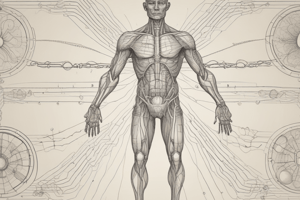Podcast
Questions and Answers
What is the primary function of homeostasis in the human body?
What is the primary function of homeostasis in the human body?
Which of the following is an effector in a homeostatic control system?
Which of the following is an effector in a homeostatic control system?
Which component of a control system receives information from the detector?
Which component of a control system receives information from the detector?
Which feedback mechanism amplifies the initial changes?
Which feedback mechanism amplifies the initial changes?
Signup and view all the answers
What happens when negative feedback is applied in a physiological process?
What happens when negative feedback is applied in a physiological process?
Signup and view all the answers
The process of blood clotting is an example of...
The process of blood clotting is an example of...
Signup and view all the answers
During labor, the release of oxytocin leading to more uterine contractions is an example of?
During labor, the release of oxytocin leading to more uterine contractions is an example of?
Signup and view all the answers
What is the normal pH of the extracellular fluid that must be maintained for tissue survival?
What is the normal pH of the extracellular fluid that must be maintained for tissue survival?
Signup and view all the answers
What occurs when the pH of the ECF decreases?
What occurs when the pH of the ECF decreases?
Signup and view all the answers
In what fluid are the body cells bathed?
In what fluid are the body cells bathed?
Signup and view all the answers
Flashcards
Homeostasis
Homeostasis
The process of regulating the internal environment of the body.
Interstitial Fluid
Interstitial Fluid
The fluid surrounding body cells, providing nutrients.
Control System Components
Control System Components
The three parts are Detector, Control Center, and Effector.
Detector
Detector
Signup and view all the flashcards
Control Center
Control Center
Signup and view all the flashcards
Effector
Effector
Signup and view all the flashcards
Negative Feedback Mechanism
Negative Feedback Mechanism
Signup and view all the flashcards
Positive Feedback Mechanism
Positive Feedback Mechanism
Signup and view all the flashcards
Blood Clotting
Blood Clotting
Signup and view all the flashcards
pH Regulation
pH Regulation
Signup and view all the flashcards
Study Notes
Homeostasis
- Homeostasis is the process of maintaining a stable internal environment
- The internal environment is regulated and maintained
- Body cells exist in a water-based medium (interstitial fluid)
- Cells absorb nutrients from the surrounding interstitial fluid
Control Systems of Homeostasis
- Homeostasis is maintained by control systems that detect and respond to changes in the internal environment
- Control systems have three components:
- Detector
- Control center
- Effector
Detector
- Detectors are sensors that sense any change in pressure, concentration, volume, etc., in the internal environment
- The detector transmits information to the control center
Control Center
- The control center determines the limit within which a variable factor should be maintained
- It receives information from the detector and responds accordingly
Effector
- The effector is the structure that makes the necessary adjustments to bring about the change
Feed Back Mechanisms
- Feedback mechanism: A process that provides information about a change to allow adjustments to counteract the change.
- Positive feedback mechanisms: The change is amplified further in the same direction (e.g., blood clotting, child birth)
- Negative feedback mechanisms: The change is counteracted, returning the system to normal (e.g., blood sugar regulation, temperature control, and fluid balance)
Negative Feedback Mechanism
- Negative feedback mechanisms maintain the variable factor close to a set point through a series of changes
- The system reverses the direction to bring the variable factor back to normal
Positive Feedback Mechanism
- The change in the variable factor is amplified, leading to a greater response in the same direction
- Amplifies the change, driving the process to completion (e.g., blood clotting, childbirth)
Role of Various Systems in Homeostasis
- pH: The pH of the extracellular fluid (ECF) is maintained at 7.4. The respiratory and urinary systems regulate pH, preventing acidosis or alkalosis.
- Temperature: The body temperature is regulated by the skin, respiratory, digestive systems and skeletal muscles
- Nutrient supply: Adequate nutrients are delivered to tissues by the digestive system
Mechanism of Action of Homeostasis
- Feedback mechanisms are the methods by which changes occur in response to stimuli
- Negative feedback mechanisms are responsible for maintaining a stable internal environment
- Positive feedback mechanisms amplify the change in the variable, driving a process to completion
Studying That Suits You
Use AI to generate personalized quizzes and flashcards to suit your learning preferences.
Related Documents
Description
Test your understanding of homeostasis and its control systems. This quiz covers the components involved in maintaining a stable internal environment, including detectors, control centers, and effectors. Challenge yourself to answer questions about how these systems work together to regulate bodily functions.




